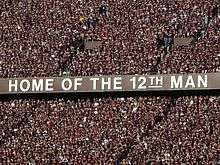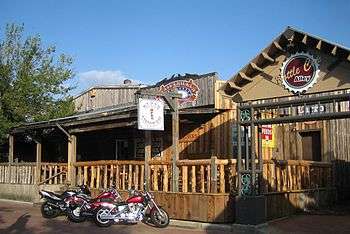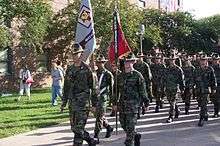Glossary of Texas A&M University terms
Many terms are unique to, or hold a special meaning connected with, Texas A&M University in College Station, Texas. The University, often called A&M or TAMU, is a coeducational public research university and is the flagship institution of the Texas A&M University System. It opened in 1876 as the Agricultural and Mechanical College of Texas, the first public institution of higher education in that state.[1] In 1963, the Texas Legislature renamed the school to Texas A&M University to reflect the institution's expanded roles and academic offerings. The letters "A&M" no longer have any explicit meaning but are retained as a link to the university's past.[2]
As a Senior Military College, Texas A&M is one of three public universities with a full-time, volunteer Corps of Cadets. It provides more commissioned officers to the United States Armed Forces than any other school outside the service academies.[3]
Texas A&M University's history as an all-male military institution has led to a unique traditions and terminology. Some phrases come from traditions that include Aggie Bonfire and the athletics program. Others phrases are locations and landmarks around the campus. While most of these terms are used exclusively by Aggies, some are used by the university's rivals. Some terms exclusively used by the Corps of Cadets are not included to narrow the list size.
0–9

A
- A&M
- The initials are part of institution's original name, the "Agricultural and Mechanical College of Texas". Term no longer has any explicit meaning in the modern institution's name, but it remains as a link to the institution's past.[2]
- Aggie (or Ag)
- A student, alumnus, or supporter of Texas A&M University.[4][5][7][9] Several other land grant schools use "Aggie", such as New Mexico State and UC Davis.[13] Adding the name of the state at the beginning of the term (i.e. "Texas Aggie") is often used to distinguish between the different schools.[9]
- "Aggies never lose, though they may run out of time"; "Aggies never lose, they just occasionally get outscored"
- These quotes or variations of them are said after losing efforts. It gives voice to the idea that the team would have eventually won if the game would have gone on longer.[5][14][15]
- Aggieland
- Name for Texas A&M and the surrounding metropolitan area, Bryan–College Station, Texas.[4][5][6][7][16] The phrase, "Welcome to Aggieland", is on the watertower in the middle of campus and on one of the decks of Kyle Field.
B

- Batt
- Short for the school newspaper, The Battalion.[4][16]
- Beat the Hell Outta (abbreviated BTHO)
- One of the Aggie yells. The phrase is followed by the name of the opposing team.[17]
- Aggie Bonfire (or Bonfire)
- A large bonfire built before the annual college football game against The University of Texas at Austin.[12] Bonfire symbolizes a "burning desire to beat the hell outta t.u."[5][18] Aggie Bonfire at one time held the world record for the height of a bonfire at 109 ft, 10 in (33 m) tall.[19] Due to the 18 November 1999 collapse of a Bonfire that killed 12 and injured 27,[20] recent non-university sanctioned Bonfires, called Student Bonfires, are now performed off-campus.[21][22]
- BQ
- Member of the Fightin' Texas Aggie Band, colloquially Band Queer, etymologically Band Qualified.[23]
- Bull
- Active duty member (usually officer) in one of the U.S. armed services. (This term should not be confused with the terms "Good Bull" or "Bad Bull")
C
- The Chicken
- Short for a popular bar frequented by A&M students, Dixie Chicken, in the entertainment district, Northgate.[4][16]
- Aggie Code of Honor
- Texas A&M's honor code: "Aggies do not lie, cheat, or steal, nor do they tolerate those who do."[4][5][7] The code is similar to the Cadet Honor Code used at the United States Military Academy.[24]
- Corps
- Short for the Texas A&M University Corps of Cadets, Texas A&M's military college program. Though Reserve Officers' Training Corps (ROTC) is mandatory for the first two years, military service is not.[5][7][12][25]
- CT
- Member of the Corps that are not in the band. Colloquially "Corps Turd," etymologically "Cadet in Training".[23][27][28]
D
- Dead (or Dead Elephant)
- Senior undergraduates during their last semester. The use of the word is a senior privilege.[4][16][29]
E
- Elephant Walk
- A tradition where the senior class walks around campus to remember the times they had at Texas A&M.[4][7][30]
F
- Fable
- noun – legendary narrative of comedy or supernatural happenings effected by an Aggie with unique Promethean consequences, intended to enforce a useful truth about that Aggie
- verb – to tell Aggie fables, call from crowd inspiring speaker to tell Aggie fables[31]

- "Farmers fight"
- Phrase used in several Aggie Yells.[9] "Farmers" comes from the original nickname of the sports teams associated with Texas A&M. "Aggies" officially replaced the nickname in 1949,[32] but the word "farmers" remains a part of a few Aggie traditions.
- Fightin' Texas Aggie
- Common prefix used for things related to A&M. For example, the Fightin' Texas Aggie Band.[5]
- Fightin' Texas Aggie Band
- Official band of Texas A&M since 1894. Members are cadets in the Corps and comprise an entire major unit of the Corps. The band is most noted for its straight line military marching and intricate close quarters drills.[5]
- Fish Camp
- An optional student-led four-day retreat for incoming freshmen held before the student's fall semester that introduces them to the traditions of Texas A&M University.[4][5][7] Transfer students can attend a separate retreat called "T-Camp",[33] and first time Texas A&M students coming in spring semester can attend "Howdy Camp".[34]
- Fish Pond
- A fountain on the Texas A&M campus that is the part of several traditions, located in front of Sbisa Dining Center.[4][5]
- Former Student
- Aggie graduates refer to themselves as "former students" rather than alumni because not all Aggies graduated due to military needs during the World Wars.[4][5][7][12] Another reason why Aggies use "former students" is that it is felt that "alumni" implies that graduates are "ex-Aggies". Aggies believe in the concept "once an Aggie, always an Aggie", and thus "alumni" would not be appropriate.[7] The Association of Former Students is the university's equivalent of an alumni association.[35]
- FOW (Freshman Orientation Week)
- Mandatory first week in the Corps just before school starts in the Fall semester for incoming freshmen cadets or Fish.[4]
- Frog
- A Transfer student that joins the corps and condenses their whole freshmen year into one semester, usually to stay on track with their graduation date. Squadron 18 is the first Frog outfit.
- "From the outside looking in you can't understand it, and from the inside looking out you can't explain it"
- Phrase used to describe the difficulty outsiders have understanding Texas A&M culture, and Aggies have articulating their passion for Texas A&M.[9][12][36]
G
- Gig 'em
- Both a saying and the thumbs up hand gesture of all Texas A&M University current and former students as sign of affiliation.[4][7][9][37] Gig 'em also is the name of an Aggie yell.[17] This tradition began at a 1930 Midnight Yell Practice held before the football game against the Texas Christian University Horned Frogs. In an attempt to excite the crowd, Pinky Downs, a 1906 Texas A&M graduate and member of the school's Board of Regents, asked the crowd "What are we going to do to those Horned Frogs?" Using a term for frog hunting, he answered his own question, "Gig 'em, Aggies!".
- Good Bull
- Anything that conforms to the traditions of Texas A&M. Members of the Corps of Cadets also use this term to signify approval of virtually anything.[5][11][16]
- Grodes
- The jeans and T-shirts worn by students who worked on Aggie Bonfire.[5] Grodes were typically not washed until Bonfire burned, if ever.[38]
- Grode yells/stories
- Non-sanctioned or approved yells "grode yells" and stories "grode stories" that are typically intended to offend or rouse. (Hooligan yell, Beers, Northside, etc...) many dorms have dorm specific grode yells. Normally led by yellow pots or crew chiefs.
H
- "Highway 6 runs both ways"
- A contractarian argument used in response to complaints made about Texas A&M, meaning that those who do not like the university are free to leave.[4][5][39] Highway 6 refers to the major highway within the Bryan–College Station area.
- Hiss (or horse laugh)
- Rather than "booing", Aggies "hiss" to express disapproval. Aggies are not supposed to boo as a "sign of class", and are not supposed to hiss a fellow Ag.[5][9][11] Hissing is a part of a yell called a horse laugh, and usually is accompanied with a hand signal that consists of one's fingers open and palms clasped together, shaken backward and forward.[17]
- "Holler House on the Brazos"
- Another name for G. Rollie White Coliseum.[40] Term rarely used after basketball and volleyball games moved to Reed Arena and the building was demolished in 2013.

- Howdy
- Texas A&M University's official greeting. Students are encouraged to greet everyone they pass on campus with a smile and a howdy.[4][41] Howdy is the preferred method for a speaker to get a large group's attention, as the members of the group are expected to return the "Howdy" back to the speaker.[5][11][12]
- Hullabaloo, Caneck! Caneck!
- Beginning phrase of the Aggie War Hymn.[4][7][9][29] The lyrics are an onomatopoeic representation of the sound a cannon being loaded, or also the sound of a train rolling through town since there is a train track that splits the campus.
- Hump it (or Humping it)
- During a yell, the crowd leans forward and places their hands on their knees to maximize the amount of air displaced during the scream. The stance forces the diaphragm to assist the lungs.[4][5][7][9][16][42]
J
- Johnny Football
- The nickname of the Aggie Heisman trophy winning quarterback Johnny Manziel.[43][44][45]

- Aggie jokes
- Jokes used against Texas A&M and Aggies, similar to jokes used against ethnic minorities[46][47] usually with a connotation of a lack of intelligence or unsophistication.[9][29][48][49]
- Jollie Rollie
- Nickname of the G. Rollie White Coliseum.[4][7] The building was demolished in 2013.
K
- Kyle Field
- The Texas A&M football stadium.[4][5]
L
- Load
- The second phase of Aggie Bonfire construction where the newly cut logs were brought back to campus.[26]
M
- Maroon
- The official color of Texas A&M along with white.[6] The University's specific trademark color is a custom Pantone color, Aggie Maroon (Hex #500000).[50] Maroon Out is an official university tradition. Each year, one football game each season is dubbed an official Maroon Out event and discounted maroon T-shirts are offered for sale to fans to fill the stadium with the Texas A&M color.[12][51] The word "maroon" is used in other contexts, such as the name of the student publication, the Maroon Weekly.[52]
- Mug down
- Kissing one's date during yell practices and football games (the latter after each Aggie score).[53]
- Muster
- Tradition on 21 April, San Jacinto Day where Aggies from all over the world meet with each other and honor those Aggies who have died that year.[5][8][12][54][55]
- MSC
- Short for the Memorial Student Center, Texas A&M's student activity center.[4][5][7][11][16][39] It is also a living memorial, dedicated to all Aggies who have given or will give their lives in wartime.
N

- New Army
- Used to represent Texas A&M's current state and student body. The phrase is often used in conjunction with complaints about changes that have happened to the institution and the attitudes of younger Aggies.[56]
- Northgate
- The entertainment district–mainly targeting A&M students–located north of the Texas A&M campus.[12][16]
- Northside
- Location of residence halls on campus near Northgate.[57]
O
- "Off the wood"
- During sporting events, Texas A&M students get off the bleachers when players on any team are injured. "Wood" is only stated because it is a tradition because Texas A&M stadiums no longer have wooden bleachers.[58]
- Old Ag
- Synonymous for a former Texas A&M student.[12]
- Ol' Rock (or Rock)
- A character who is meant to represent the prototypical Aggie used in the fables told at yell practices.[31]
- Ol' Sarge
- An unofficial mascot of A&M that is portrayed as a tough-looking corps drill sergeant.[59]

- Other education
- What Aggie students learn outside the classroom though extracurricular activities and through living life.[39][60]
P
- Pass back
- A hand signal, initiated by the Yell Leaders, which informs students which yell to do next.[61]
- Passdown
- An object of some significance that is given from an upperclassmen to a fish, and passed through several generations of students in the Corps.
- Pots
- Hard hats worn by Aggie Bonfire builders. The color of a student's pot identified their role in bonfire construction.[16][66]
- Privilege (SP, JP, ZP)
- A ranking system based on one's class year with determines what traditions and Aggie student is allowed to perform.[4] The privilege levels are, SP, JP, and ZP's, sophomore, junior, and senior privileges respectively.[16] Freshmen have "fish privileges". In the Corps, one's privilege level has an enormous effect on a cadet's lifestyle.[5] Some rules like the wildcatting or whooping extend to non-regs.
- Protein Cream
- The term used by corps fish, in place of "peanut butter," which they are not allowed to say. Saying "peanut butter" is an upper classmen privilege.
- Pull out
- Using a privileged word not available to your class; for example, sophomores saying "Whoop."[5]
- Push
- a) A form of punishment consisting of pushups, especially after pulling out. In the Corps when students do a "class set" of pushups, one for each year of their class.[5] The Class of 1945 did only 45 pushups, and while a for a few years cadets did "old Army class sets" (counting from 1900 and not reseting at 2000), the Class of 2020 now does 20, plus an extra one for the Big Dog (Ranger) if the fish in Company D-2.
- b) The last phase of Aggie Bonfire construction, where students worked around the clock in rotating shifts to finish stacking the logs.[26]
Q
R
- Ram
- (n) Demerit issued to a cadet by either a ranking cadet or a bull for a major rule violation. (v) To receive demerits.
- RAggies
- Aggie baseball fans.[67]
- Red Ass
- Students who closely follow the Aggie traditions and rules.[68]
- Reed Arena
- The university's arena.[4][69]
- Reed Rowdies
- Official fan club of Texas A&M basketball teams.[70]
- Reveille
- The Texas A&M mascot, a purebred American collie. Reveille is the highest-ranking member of the Corps of Cadets.[5][9][11][71] Freshmen cadets are required to address her as "Miss Rev, ma'am."[72]
- Ring dunk
- A non school sanctioned tradition performed after a student receives an Aggie Ring; usually involves chugging a pitcher of beer, or a non-alcoholic substitute, with their Aggie Ring in the bottom then catching the ring in their teeth.[12][73]
S
- "Saw Varsity's Horns Off"
- A verse from the Aggie War Hymn,[9][18] it refers to defeating the Texas Longhorns, who use a Longhorn steer as their mascot.[74]
- Sea Aggies (or Sea Ags)
- Students or alumni of the school's branch campus, Texas A&M University at Galveston.[75][76]

- Senior Boots
- Distinctive brown leather boots worn by Corps seniors, or Zips.[25][77]
- Serge Butt
- A nickname for a junior.[16] Refers to the "serge" material used in making pants for junior cadets pre-1960. Usually abbreviated as just "butts."
- Singing Cadets
- An all male choir, one of the three Choral Activities choirs at A&M, called the "Voice of Aggieland".[78] While Corps members may join the Singing Cadets, one does not have to be a member of the Corps to join the Singing Cadets.
- Silver Taps
- A ceremony, held monthly, to honor all enrolled students who died in the previous month.[6][11][12][79]
- "Sit down bus driver"
- An Aggie Yell used in athletic events to taunt opposing team's coaches when they are arguing with an official or otherwise holding up the game. "Bus driver" refers to the fact that coaches used to drive the buses for road games.[9]
- Southside
- Residence halls on the far southeast portion of campus.[80]
- Aggie Spirit (or Spirit of Aggieland)
- Describes the unity and devotion Aggies have for their school and to each other.[4][5][11][81] "The Spirit" also refers to the school song, The Spirit of Aggieland.
- Stack
- The third phase of Aggie Bonfire construction, where students would wire the logs together in their final shape.[12][26]
- Sully (or Sul Ross)
- Short for former Texas A&M President, Lawrence Sullivan Ross. Modern usage generally refers to the prominent statue of him on campus, often covered in pennies from students as a "good luck" tradition.[5]
T
- TAMC (or Texas AMC)
- Refers to the university's former name the "Agricultural and Mechanical College of Texas". While the institution has been renamed Texas A&M University with the initials TAMU, the initials AMC are still used in several Aggie traditions including Aggie yells and the Spirit of Aggieland."[2]
- Tea-sip (or t-sip)
- A student of Texas A&M's archrival, The University of Texas at Austin.[4][7] The term is intended to be derogatory (the origin being that while Aggies were off fighting wars, students of UT Austin were "sipping tea" at home).
- TexAgs
- An independent Texas A&M website, one of the largest collegiate independent websites in the country. "TexAgs" has been used colloquially in relationship to the use of the site's internet forum.[82]
- t.u.
- What Aggies call The University of Texas at Austin, normally abbreviated UT, the main rival school to Texas A&M University. Term is intended to be derogatory.[18] Aggies maintain that UT is "a" university in Texas not "the" university of Texas. The t.u. therefore stands for "texas university", with the lowercase letters being an added insult.[4][7][39]
W

- Aggie War Hymn
- Texas A&M's fight song.[12]
- Whip Out (or Whipping Out)
- The tradition of freshmen in the Corps of Cadets introducing themselves to upperclassman in the Corps. Sophomores whip out to juniors and seniors while juniors only whip out to seniors.[4][5][39][83]
- White
- The second official Texas A&M color.[6][50] White Out is a basketball tradition. Unlike football games, where Aggie fans wear Maroon, the basketball crowds wear white.[84]
- "Whoop"
- An exclamation of approval and excitement, especially used at the end of a yell. This is a junior and senior privilege.[4][85]
- Wildcat
- A noise and a hand motion made after an Aggie yell. Each class uses a different wildcat based on seniority.[4][5][11]
- Wrecking Crew
- Name given to defenses of the football team.[86][87] The term became popular during in 80s and the 90s. Many fans, coaches, and sports analysts feel that recent Aggie defenses have not "earned" the title.[87][88]
Y

- Aggie Yells
- Synchronized yells done at Aggie sporting events.[5][12]
- Yell Leaders
- Texas A&M's equivalent of cheerleaders – These elected students, three seniors and two juniors, lead the student body in synchronized yells throughout all sporting events and yell practices.[4][9][42][89] While all yell leaders on the main campus have been male, a female has served as one at the school's branch campus in Galveston.[90]
- Yell practice
- A Texas A&M event that is similar to a pep rally. The most notable yell practices, Midnight Yell, occurs the night before home football games.[4][7][42]
Z
- Zip (or Zipper-Head)
- A nickname for a senior, named so for the black and gold braid on the garrison caps of seniors in the Corps of Cadets, which resembles a zipper.[4][16][25]
References
- ↑ "About Texas A&M University". Texas A&M University. Retrieved 20 February 2008.
- 1 2 3 Dethloff, Henry C. (2010-06-15). ""Texas A&M University", Handbook of Texas Online". Texas State Historical Association. Retrieved 2015-05-26.
- ↑ Kever, Jeannie (12 December 2008). "Bush urges A&M grads to consider a life of service". Houston Chronicle. Retrieved 25 December 2008.
- 1 2 3 4 5 6 7 8 9 10 11 12 13 14 15 16 17 18 19 20 21 22 23 24 25 26 27 28 29 30 31 32 33 34 "The Aggie Dictionary". TheEagle.com. The Bryan-College Station Eagle. Archived from the original on 14 October 2007. Retrieved 3 January 2011.
- 1 2 3 4 5 6 7 8 9 10 11 12 13 14 15 16 17 18 19 20 21 22 23 24 25 26 27 28 29 30 31 32 33 34 35 36 Stanford, Frank S. (December 2003). "Escaping the Frozen Lake: Individual and Social Idealism Manifest As Forms of Religion and Religiosity: A Dissertation" (PDF). Office of Graduate Studies of Texas A&M University: 109–110. Retrieved 13 September 2007.
- 1 2 3 4 5 6 Nissimov, Ron (7 May 2000). "A&M ponders scathing words in wake of Bonfire tragedy". Houston Chronicle. Retrieved 1 January 2009.
- 1 2 3 4 5 6 7 8 9 10 11 12 13 14 15 16 17 18 "Aggie Terminology". Texas A&M Athletics. 2007. Archived from the original on 10 April 2008. Retrieved 3 January 2011.
- 1 2 Scharf, Steve (18 July 2008). "Big 12 schools are rich in tradition". The Daily Nebraskan. University of Nebraska. Retrieved 25 December 2008.
- 1 2 3 4 5 6 7 8 9 10 11 12 13 14 Greenwald, Michael (14 December 2006). "Crash course in Rooting for Aggies". San Diego Union-Tribune. Retrieved 25 December 2008.
- ↑ Cook, Beano (8 October 2006). "Ten Days That Shook the Sport". ESPN. Retrieved 2 February 2008.
- 1 2 3 4 5 6 7 8 9 "Traditions a major part of A&M life". The Battalion. 9 February 2008. Retrieved 7 December 2008.
- 1 2 3 4 5 6 7 8 9 10 11 12 13 14 15 Paddon, Meredith (April 2007). "Southern Reveille: Southern Culture and Tradition at Texas A&M University" (PDF). Texas A&M University. Retrieved 9 January 2009.
- ↑ "New Mexico State Aggies". College Football Data Warehouse. Archived from the original on 8 June 2007. Retrieved 18 February 2008.
- ↑ "Aggie Traditions". TAMU.edu. Texas A&M University. Retrieved 21 September 2007.
- ↑ "Aggie Traditions – Twelfth Man". Retrieved 25 March 2011.
- 1 2 3 4 5 6 7 8 9 10 11 12 13 14 15 "Corps Dictionary". Texas A&M University. 13 May 2007. Archived from the original on 3 August 2008. Retrieved 3 January 2010.
- 1 2 3 "Yells". Texas A&M University Yell Leaders. Retrieved 19 December 2007.
- 1 2 3 Harris, Patrick. "War Hymn". Retrieved 18 September 2007.
- ↑ Morris, Dave (8 December 1999). "Memories of an Aggie bonfire boy". Salon.com. Archived from the original on 11 February 2007. Retrieved 14 August 2007.
- ↑ "Texas A&M students killed, trapped in collapse of bonfire logs". CNN. 18 November 1999. Retrieved 19 December 2008.
- 1 2 Watkins, Matthew (17 November 2005). "Off-campus bonfire". The Battalion. Retrieved 21 February 2008.
- ↑ Hensley, Laura (1 November 2006). "A year after fiasco, student bonfire set to burn". The Bryan–College Station Eagle. Retrieved 3 March 2007.
- 1 2 3 Gravois, John (5 January 2007). "Memorandum". 53 (18). The Chronicle of Higher Education: A6.
At A&M, we call our sophomore cadets "pissheads," we call our Fightin' Texas Aggie Band members "band queers,"
|section=ignored (help) - ↑ Melgoza, Pauline; Jane Smith (2008). "Revitalizing an Existing Honor Code Program". Innovative Higher Education. 32 (4): 209–219. doi:10.1007/s10755-007-9048-6.
- 1 2 3 4 "'Fish,' 'spurs' and 'zips': Equality Riders Experience military culture of Texas A&M" (Press release). Soul Force. 29 March 2006. Retrieved 18 February 2008.
- 1 2 3 4 Cook, John Lee, Jr. (November 1999). "Bonfire Collapse, Texas A&M University" (PDF). U.S. Fire Administration. Retrieved 3 March 2007.
- ↑ "New Student Booklet" (doc). Texas A&M University Department of English. Retrieved 3 January 2011.
- ↑ http://www.houstonpress.com/2008-01-24/news/rotten-to-the-corps-a-question-of-justice-at-texas-a-m/
- 1 2 3 "Elephant Walk". San Antonio Aggie Moms. December 2004. Retrieved 21 February 2008.
- ↑ Abram, Lynwood (7 August 2002). "Earl Patterson, A&M's oldest drum major, 99". Houston Chronicle. Retrieved 16 August 2007.
- 1 2 Morris, David (23 June 2008). "'Ol' Rock' Mired in Relatively New Tradition". The Battalion. Retrieved 29 December 2013.
- ↑ "Frequently Asked Questions". Texas A&M University. Retrieved 7 May 2012.
- ↑ "T-Camp". Texas A&M University: Student Activities. 2009. Retrieved 11 January 2009.
- ↑ "Howdy Camp". Texas A&M University: Student Activities. 2009. Retrieved 11 January 2009.
- ↑ "The Association of Former Students". The Association of Former Students. Retrieved 22 February 2008.
- ↑ Burka, Paul (November 2006). "Agent of change". Texas Monthly. Retrieved 23 September 2007.
- ↑ Burka, Paul. "Football Hand Signals". Texas Monthly. Emmis Publishing LP. Archived from the original on 30 September 2007. Retrieved 10 July 2007.
- ↑ Stratton, W.K. (3 September 2002). Backyard Brawl: Inside the Blood Feud Between Texas and Texas A&M. Crown. pp. 100–101. ISBN 0-609-61053-8.
- 1 2 3 4 5 Burka, Paul (1 April 1997). "Did You Hear the One About The New Aggies?". Texas Monthly. Retrieved 4 February 2008.
- ↑ "Facilities". Texas A&M University College of Education and Human Development. Retrieved 13 April 2011.
- ↑ "Aggie Traditions". TAMU.edu. Texas A&M University. Retrieved 21 September 2007.
- 1 2 3 Schabach, Mark (14 October 2006). "Texas A&M hoops finds place on football's back". ESPN. Retrieved 26 July 2007.
- ↑ KBTX Sports. "Johnny Football: A nickname coined in Aggieland, a legend crafted in the Hill Country". Retrieved 23 September 2012.
- ↑ John Taylor (2012-10-21). "'Johnny Football' one of two Camp honorees". College Football Talk. NBC Sports. Retrieved 2014-01-01.
- ↑ Duffy, Ty (2013-02-25). "Johnny Manziel Trademarked "Johnny Football," Can Profit From T-Shirt Lawsuit". The Big Lead. Gannett Company. Retrieved 2014-01-01.
- ↑ Bynum, Joyce (1991). ""Ethnic" Jokes and Texas Aggies". ETC:: A Review of General Semantics. 48 (3): 320–328. ISSN 0014-164X.
- ↑ Wukasch, Charles (July 1969). "American Numskull Tales: The Aggie Joke". Western Folklore. 28 (3): 214–215. ISSN 0043-373X.
- ↑ Johnson, Judy (2002-04-29). "Aggie Jokes". ENG123 Texas Culture. Retrieved 2008-01-27.
- ↑ Read, Nat B. Jr. (1978). "Football with a Difference". The Saturday Evening Post. pp. 126–127.
- 1 2 "Texas A&M University Brand Guide". Texas A&M Division of Marketing and Communications. 2012. Retrieved 10 May 2012.
- ↑ "Maroon Out History". Maroon Out T-shirts. Retrieved 26 July 2007.
- ↑ "The Maroon Weekly: About Us". The Maroon Weekly. Archived from the original on 23 August 2007. Retrieved 30 June 2007.
- ↑ Haskins, Maggie (4 November 2004). "The Perfect Week". Sports Illustrated on Campus. Retrieved 13 January 2008.
- ↑ "Aggie Muster". Texas A&M University. Retrieved 26 December 2008.
- ↑ Spencer, Jason (23 April 2004). "Brother's death shows UT grad meaning of Muster". Houston Chronicle. Retrieved 16 August 2007.
- ↑ "Skyrocket yell's lift-off should be grounded". The Battalion. 30 September 2003. Retrieved 11 May 2012.
- ↑ "Northside Halls". Texas A&M University. 2007. Retrieved 30 April 2007.
- ↑ Ivey, Tommi (19 October 2005). "Aggies should not walk on A&M seal" Check
|url=value (help). The Battalion. Retrieved 20 August 2007. - ↑ Salazar, Andrea (19 October 2013). "Beloved unofficial A&M mascot Ol' Sarge Celebrates 75th Birthday". The Eagle. Retrieved 29 December 2013.
- ↑ Hughes, Robin L. (1 April 1999 2007). "Traditions of Change: Student Expectations for the Other Education" (PDF). Montreal, Canada. ED461341. Retrieved 23 September 2007. Check date values in:
|date=(help) - ↑ Axtman, Chris (6 November 2001). "Texas school where pompoms aren't welcome". Christian Science Monitor. Retrieved 26 July 2007.
- ↑ "SI.com's 2003 Team Previews: Texas A&M Aggies". Athlon Sports. SI.com. Retrieved 5 January 2009.
- ↑ Millender, Shawn C. (7 December 2004). "Thoughts on A&M football". The Battalion. Retrieved 5 January 2009.
- ↑ Barnhouse, Wendell (12 November 2006). "Turning corner to where?". Fort Worth Star-Telegram.
- ↑ Hoffer, Richard (30 December 1985). "It's a Real-Life Dallas Soap Opera Texas A&M Probe Somewhat Overshadows Cotton Bowl". Los Angeles Times.
- ↑ "Official Bonfire 2002 website". Scout.com. Retrieved 25 December 2008.
- ↑ "Road Trip: College Station, Texas". Sports Illustrated. Retrieved 9 June 2007.
- ↑ Smith, Jonathan M (2007). "The Texas Aggie Bonfire: A Conservative Reading of Regional Narratives, Traditional Practices, and a Paradoxical Place". Annals of the Association of American Geographers. Annals of the Association of American Geographers. 97: 182–201. doi:10.1111/j.1467-8306.2007.00530.x. Retrieved 15 August 2007.
- ↑ "Reed Arena". Texas A&M University — Division of Finance. Retrieved 19 December 2008.
- ↑ "Reed Rowdies". Texas A&M University. Retrieved 17 February 2008.
- ↑ Brown, Chip (21 July 1997). "Some Aggies see red over moving grave site of mascots". Houston Chronicle. Retrieved 16 August 2007.
- ↑ Filbin, Melissa (22 August 2007). "Traditions 101". The Battalion. Retrieved 14 September 2007.
- ↑ Wirt, Ashley (9 September 2006). "Aggies find new ways of 'ring dunking'". The Battalion. Retrieved 13 January 2008.
- ↑ "Mascot Power Rankings". Sports Illustrated. 9 August 2007. Retrieved 20 September 2007.
- ↑ Willett, Lorelei (11 September 2009). "Sea Aggies readjust to regular college life in Galveston". The Battalion. Retrieved 21 September 2009.
- ↑ Kever, Jeannie (14 December 2008). "'Sea Aggies' return to Galveston for graduation". Houston Chronicle. Retrieved 21 September 2009.
- ↑ "Senior Boots — Texas Aggie Traditions". Texas A&M University. Retrieved 25 December 2008.
- ↑ Edwards, Stacy (5 September 2008). "South American serenade". The Battalion. Retrieved 9 December 2008.
- ↑ Hegstrom, Edward (8 December 1999). "'Silver Taps' honors Aggie Bonfire victims". Houston Chronicle. Retrieved 16 August 2007.
- ↑ "Residence Halls by Style — Commons". Texas A&M University. 2007. Retrieved 30 April 2007.
- ↑ "Aggie Spirit". Official website of Texas A&M University Class of 72. Retrieved 13 January 2008.
- ↑ Buckley, Christopher B. (23 June 2008). "Cyber Fanatics: TexAgs.com fans commune online". The Battalion.
- ↑ Zuehlke, Lara (October 2001). "Joe B. Foster '56". Mays Business School. Archived from the original on 22 May 2007. Retrieved 3 January 2011.
- ↑ Huffman, Holly (27 January 2007). "Attendance at Reed Arena rises with number of wins". Bryan–College Station Eagle. Retrieved 26 July 2007.
- ↑ Hughes, Polly Ross (28 November 1999). "Aggie Spirit". Houston Chronicle. Retrieved 16 August 2007.
- ↑ Ruff, Brian (30 September 2001). "Wrecking Crew salvages A&M season opener". The Battalion. Retrieved 17 February 2008.
- 1 2 Griffin, Tim (28 July 2008). "Revisiting the 'Wrecking Crew' and 'Blackshirts'". ESPN. Retrieved 3 January 2011.
- ↑ Onan, John (6 March 2006). "Aggies defense must earn "Wrecking Crew" label". Real Football 365. Retrieved 3 December 2008.
- ↑ Alvarado, Nicole (20 April 2007). "Yell Leaders represent Aggie Spirit past, present, and future". The Battalion. Retrieved 29 May 2007.
- ↑ Filbin, Melissa (20 September 2005). "First woman yell leader elected at A&M-Galveston". The Battalion. Retrieved 21 September 2009.
External links
| Wikimedia Commons has media related to Texas A&M University. |
- Corps dictionary – An archived web page which was in depth dictionary of Corps of Cadets exclusive terminology
- Texas A&M University
